Coupling Exergy with the Emission of Greenhouse Gases in Bioenergy: A Case Study Using Biochar
Abstract
1. Introduction
2. Materials and Methods
2.1. Bioenergy Systems, GHG and Exergy
- Level 1: Direct inputs, considered beyond the Sun, fuel consumption and the electric energy occasionally taken from an external source;
- Level 2: Indirect energy inputs, where it is added to the first level of the energy/emissions associated with the production of other inputs, either by the crop or through the manufacturing process;
- Level 3: The energy/emissions, related to the production and maintenance of equipment and installations, added to the previous levels. In this study, level 3 was used.
- An increase in productivity of 10%;
- A decrease in nitrous oxide emissions of 23%.
2.2. Accounting for Emissions and Exergy
- Scenario 1, without the use of biochar, as shown in Equation (11);
- Scenario 2, with the use of biochar, as shown in Equation (12).
3. Results
3.1. The Biochar Changing Scenarios
3.2. Scanning Production and N2O Emissions
3.2.1. The CEENE Behavior
3.2.2. The GHG Behavior
3.2.3. The Behavior ratio of CEENE: GHG and the Linear Function Result
4. Discussion
5. Conclusions
Author Contributions
Funding
Acknowledgments
Conflicts of Interest
Nomenclature
| physical exergy (J) | |
| chemical exergy (J) | |
| potential exergy (J) | |
| exergy molar chemical component i (J/mol) | |
| T | temperature (K) |
| T0 | reference temperature (K) |
| P | pressure (bar) |
| P0 | reference pressure (bar) |
| H | enthalpy (J) |
| H0 | reference enthalpy (J) |
| ΔHph | physical enthalpy variation (J) |
| S | entropy (JK−1) |
| S0 | reference entropy (JK−1) |
| ΔSph | physical entropy variation (JK−1) |
| R | ideal gas constant (Jmol−1 k−1) |
| cumulative exergy consumption (MJ/MJ ethanol) | |
| cumulative exergy extraction from the natural environment (MJ/MJ ethanol) | |
| GHG emissions (g CO2-equivalent/MJ ethanol) | |
| exergy: emissions ratio scenario 1 (MJ/kg CO2-equivalent) | |
| exergy: emissions ratio scenario 2 (MJ/kg CO2-equivalent) | |
| exergy: emissions ratio scenario j (MJ/kg CO2-equivalent) | |
| exergy: emissions ratio variable (MJ/g CO2-equivalent) | |
| coefficient of sensitivity in Xi | |
| φi: | fugacity coefficient of the i component |
References
- BP Energy Outlook—2017 Edition. Available online: http://www.bp.com/energyoutlook#BPstats (accessed on 8 March 2018).
- Graedel, T.E.; Allenby, B.R. Industrial Ecology: Policy Framework and Implementation, 2nd ed.; Prentice Hall: Englewood Cliffs, NJ, USA, 1999. [Google Scholar]
- Kotas, T.J. Basic exergy concepts. In The Exergy Method of Termal Plant Analysis; Reprint Edition; Krienger Publishing Company: Malabar, FL, USA, 1995; pp. 29–56. [Google Scholar]
- Sciubba, E.; Wall, G. A brief Commented History of Exergy from the Beginnings to 2004. Int. J. Chem. Thermodyn. 2007, 10, 1–26. [Google Scholar]
- Wall, G. Exergy and resource accounting. In Exergy—A Useful Concept within Resource Accounting; Institute of Theoretical Physics, Chalmers University of Technology and University of Göteborg: Göteborg, Sweden, 1977; pp. 15–36. [Google Scholar]
- Rifkin, J.; Howard, T. Entropy into the Greenhouse World; Revised Edition; New Age Book: New York, NY, USA, 1990. [Google Scholar]
- Cornelissen, R.L. Thermodynamics and Sustainable Development. Ph.D. Thesis, University of Twente, Enschede, The Netherlands, 1997. [Google Scholar]
- Szargut, J.; Morris, D.R. Cumulative Exergy Consumption and Cumulative Degree of Perfection. In Exergy Analysis of Thermal, Chemical and Metallurgical Processes, 1st ed.; Hemisphere Publishing: New York, NY, USA, 1988; pp. 171–191. [Google Scholar]
- Dewulf, J.; Bösch, M.E.; De Meester, B.; Van Der Vorst, G.; Van Langenhove, H.; Hellweg, S.; Huijbregts, M.A.J. Cumulative exergy extraction from the natural environment (CEENE): A comprehensive life cycle impact assessment method for resource accounting. Environ. Sci. Technol. 2007, 41, 8477–8483. [Google Scholar] [CrossRef] [PubMed]
- Mcmanus, M.C.; Taylor, C.M. The changing nature of life cycle assessment. Biomass Bioenergy 2015, 82, 13–26. [Google Scholar] [CrossRef] [PubMed]
- Macedo, I.C.; Leal, M.R.L.V.; Silva, J.E.A.R. Balanço das emissões de gases do efeito estufa na produção e no uso do etanol no Brasil; Núcleo Interdisciplinar de Planejamento Energético da Universidade Estadual de Campinas–NIPE/UNICAMP: Campinas, SP, Brasil, 2004; pp. 9–37. [Google Scholar]
- Szargut, J. Calculation of exergy. In Exergy Method—Tecnical and Ecological Applications, 1st ed.; WIT Press: Southampton, UK, 2005; pp. 19–54. [Google Scholar]
- Hoang, V.N.; Rao, D.S.P. Measuring and decomposing sustainable efficiency in agricultural production: A cumulative exergy balance approach. Ecol. Econ. Mag. 2010, 69, 1765–1776. [Google Scholar] [CrossRef]
- Maes, D.; Passel, S.V. Advantages and limitations of exergy indicators to assess sustainability of bioenergy and biobased materials. Environ. Impact Assess. Rev. 2014, 45, 19–29. [Google Scholar] [CrossRef]
- Hovelius, K.; Wall, G. Energy, exergy and emergy analysis of a renewable energy system based on biomass production. In Proceedings of the Efficiency, Costs, Optimization, Simulation and Environmental Aspects of Energy Systems, ECOS’98, Nancy, France, 8–10 July 1998; pp. 1197–1204, ISBN 2-905-267-29-1. [Google Scholar]
- Saltelli, A.; Ratto, M.; Andres, T.; Campolongo, F.; Cariboni, J.; Gatelli, D.; Saisana, M.; Tarantola, S. Elementary Effects Method. In Global Sensitivity Analysis; John Wiley & Sons Ltd.: Chichester, UK, 2008; pp. 109–131. [Google Scholar]
- Hamby, D.M. A review of techniques for parameter sensitivity analysis of environmental models. Environ. Monit. Assess. 1994, 32, 135–154. [Google Scholar] [CrossRef] [PubMed]
- Scilab (Version 6.0.1). Available online: http://www.scilab.org/download/6.0.1 (accessed on 4 June 2018).
- Macedo, I.C.; Seabra, J.E.A.; Silva, J.E.A.R. Green house gases emissions in the production and use of ethanol from sugarcane in Brazil: The 2005/2006 averages and a prediction for 2020. Biomass Bioenergy 2008, 32, 582–595. [Google Scholar] [CrossRef]
- ANP (Agência Nacional de Petróleo). Available online: www.anp.gov.br/?dw=82253 (accessed on 17 October 2018).
- Dirbeba, M.J.; Brink, A.; Demartini, N.; Zevenhoven, M.; Hupa, M. Potential for thermochemical conversion of biomass residues from the integrated sugar-ethanol process: Fate of ash and ash-forming elements. Bioresour. Technol. 2017, 234, 188–197. [Google Scholar] [CrossRef] [PubMed]
- Kamate, S.; Gangavati, P. Exergy analysis of cogeneration power plants in sugar industries. Appl. Therm. Eng. 2009, 29, 1187–1194. [Google Scholar] [CrossRef]
- Santos, N.A.V.; Vieira, S.S.; Mendonça, F.G.; Napolitano, M.N.; Nunes, D.M.; Ferreira, R.A.R.; Soares, R.R.; Magriotis, Z.M.; Araujo, M.H.; Lago, R.M. Rejeitos de Biomassas Oriundas da Cadeia de Biocombustíveis no Brasil: Produção de Bio-óleo e Sub-produtos. Rev. Virt. Quím. 2017, 9, 1–21. [Google Scholar]
- Palacios-Bereche, R.; Mosqueira-Salazar, K.J.; Modesto, M.; Ensinas, V.A. Exergetic analysis of the integrated first and second-genaration etanol production from sugarcane. Energy 2013, 62, 46–61. [Google Scholar] [CrossRef]
- Zhang, H.; Xiao, R.; Jin, B.; Shen, D.; Chen, R.; Xiao, G. Catalytic fast pyrolysis of straw biomass in an internally interconnected fluidized bed to produce aromatics and olefins: Effect of different catalysts. Bioresour. Technol. 2013, 137, 82. [Google Scholar] [CrossRef] [PubMed]
- NOVACANA. Available online: https://www.novacana.com/cana/glossario-de-indicadores-de-pd-na-cadeia-produtiva-cana-etanol (accessed on 27 November 2018).
- INPE (Atlas Brasileiro de Energia Solar, 2006). Available online: ftp.cptec.inpe.br/labren/publ/livros/brazil_solar_atlas_R1.pdf (accessed on 2 November 2017).
- Jeffery, S.; Verheijen, F.G.A.; Velde, M.; Bastos, A.C. A quantitative review of the effects of biochar application to soils on crop productivity using meta-analysis. Agric. Ecosyst. Environ. 2011, 144, 175–187. [Google Scholar] [CrossRef]
- Cayuelaa, M.L.; van Zwietenb, L.; Singhb, B.P.; Jefferyc, S.; Roiga, A.; Sánchez-Monedero, M.A. Biochar’s role in mitigating soil nitrous oxide emissions: A review and meta-analysis. Agric. Ecosyst. Environ. 2014, 191, 5–16. [Google Scholar] [CrossRef]
- IPCC - Fifth Assessment Report (AR5). Available online: /www.ipcc.ch/report/ar5/syr/2014 (accessed on 10 November 2017).
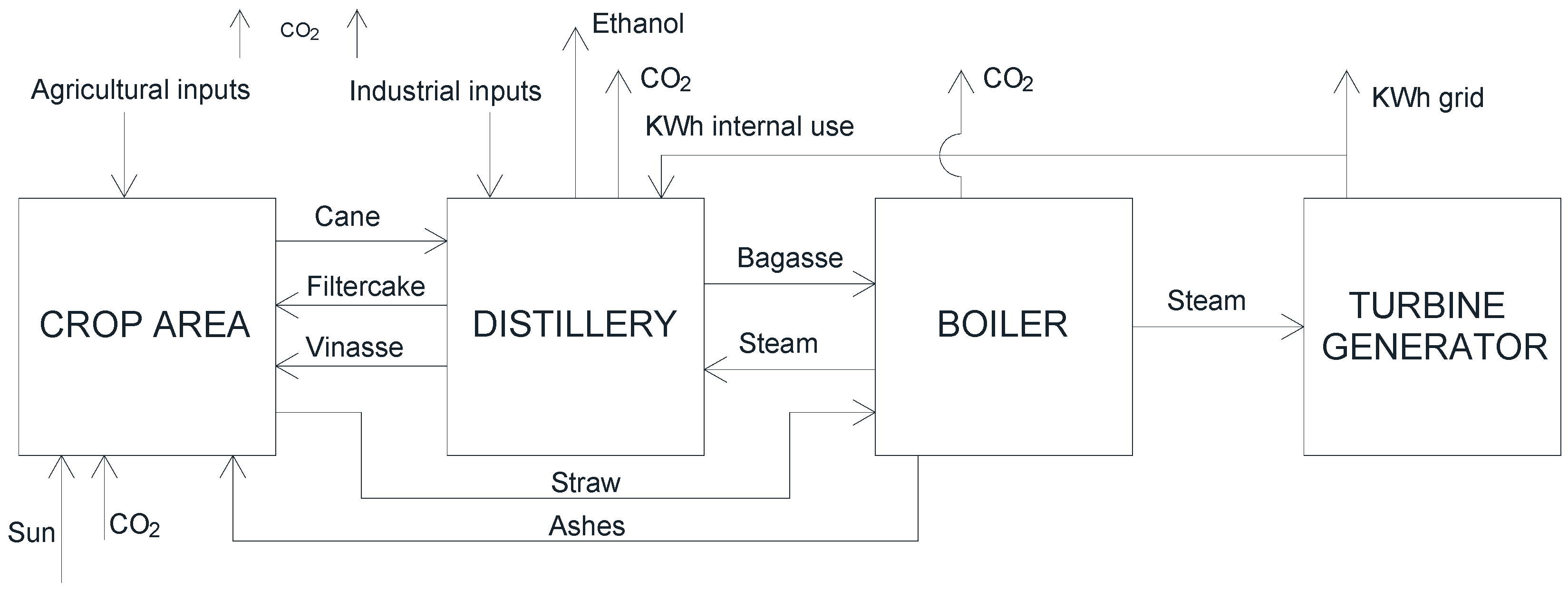
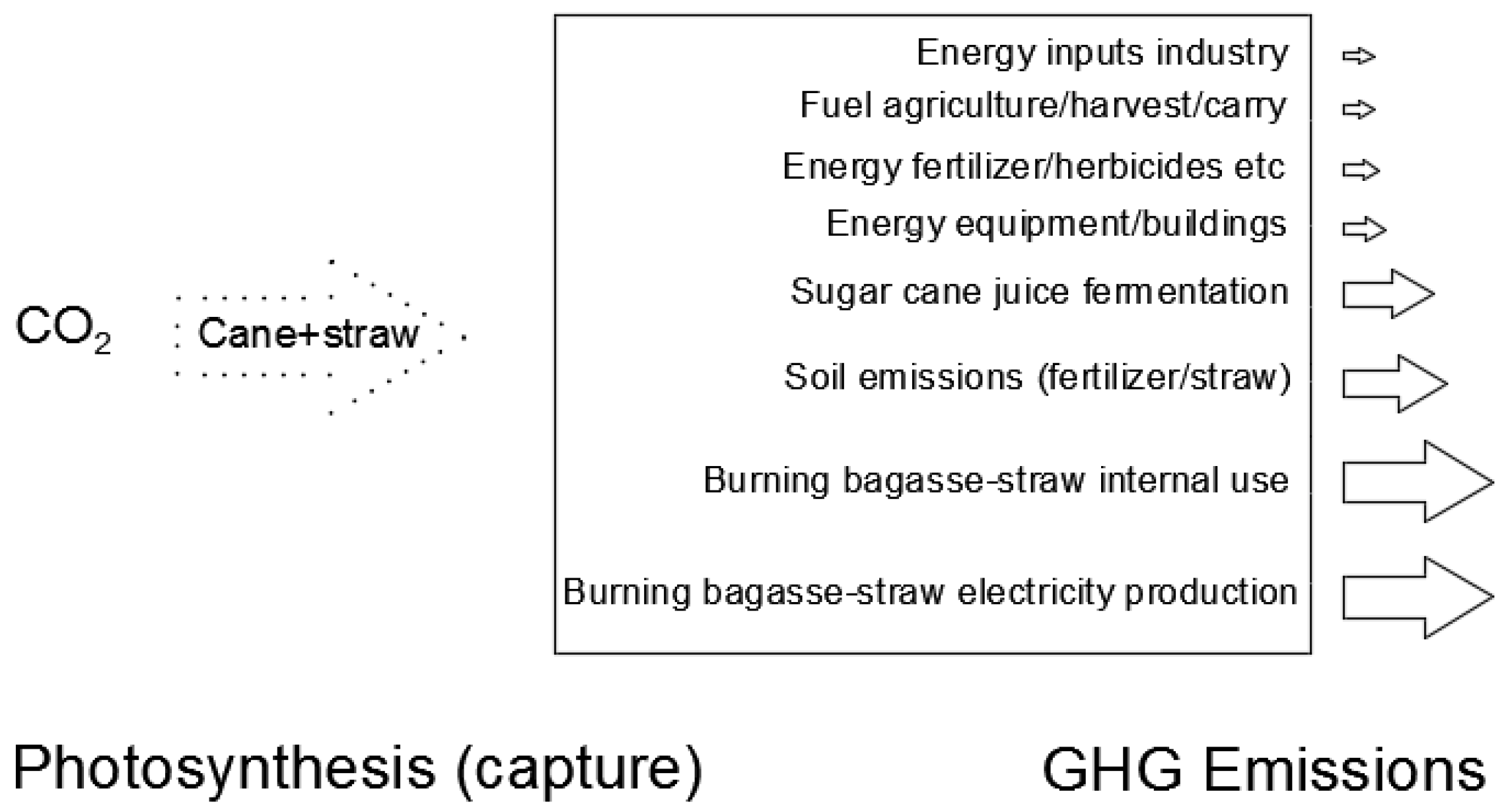
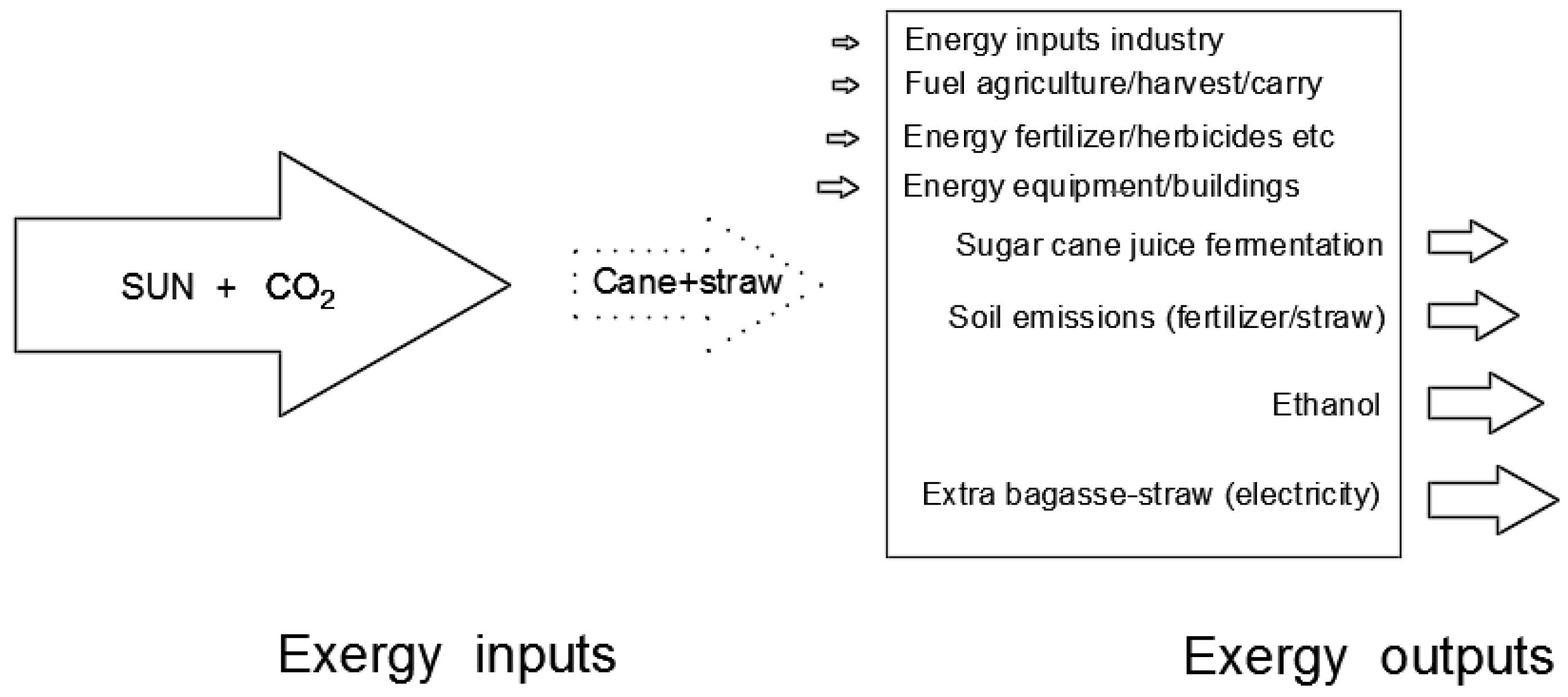
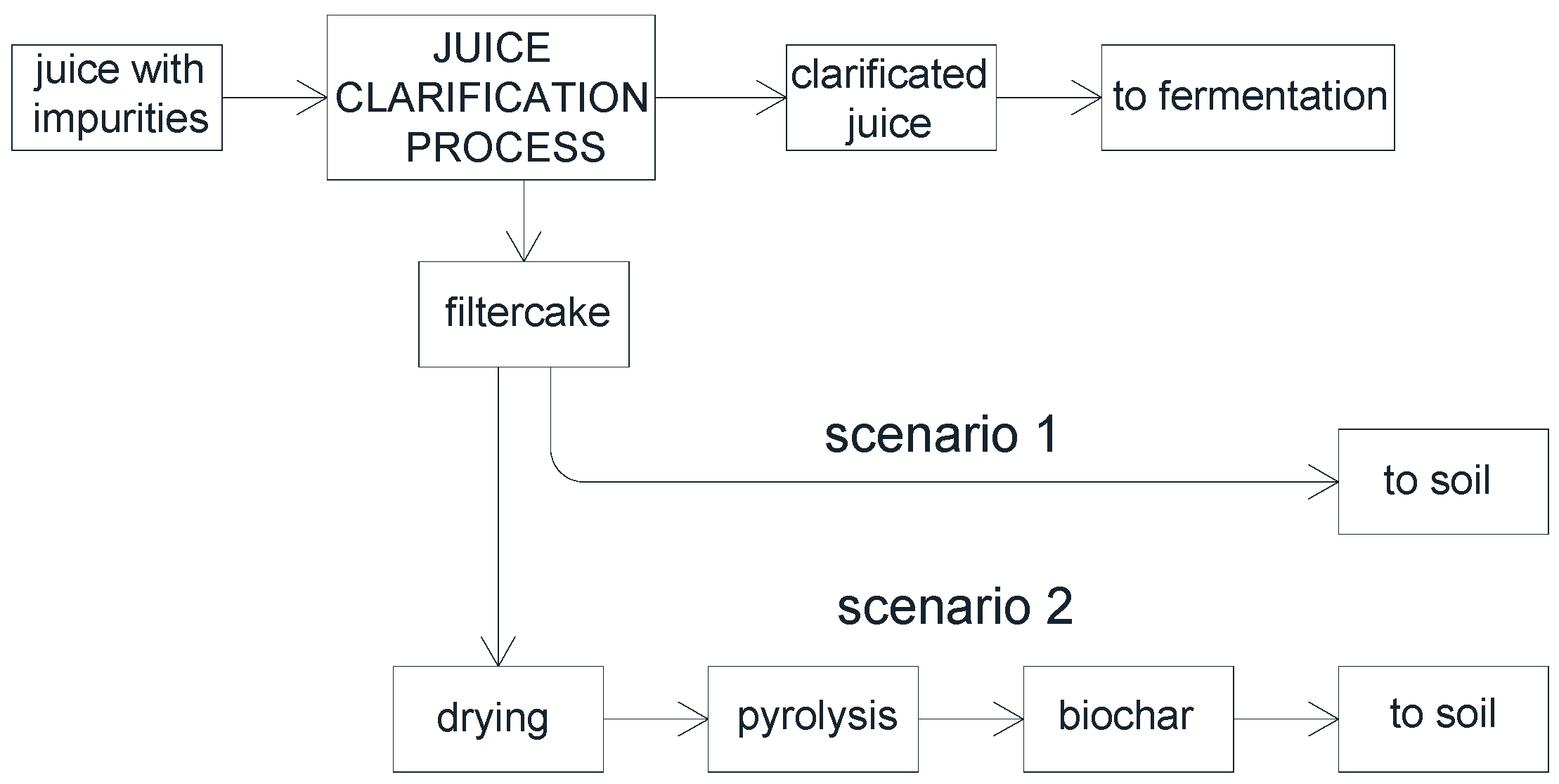
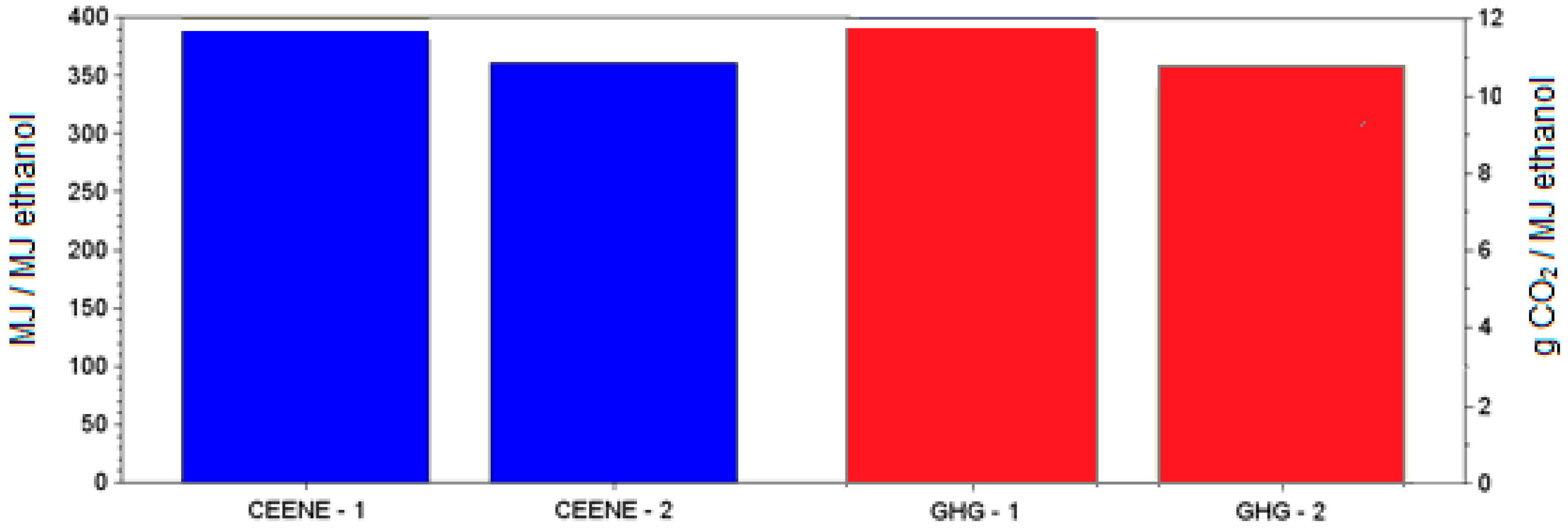
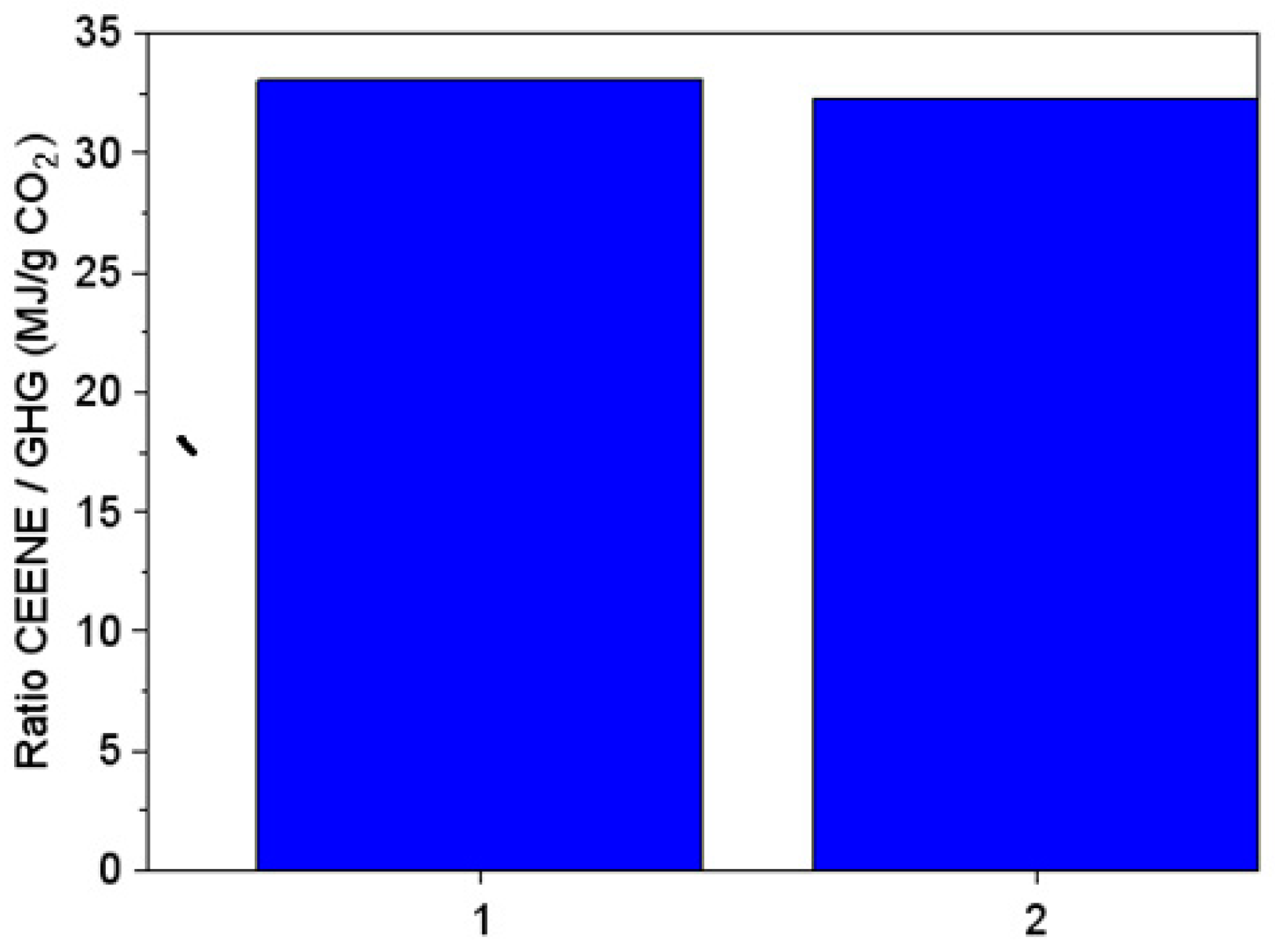
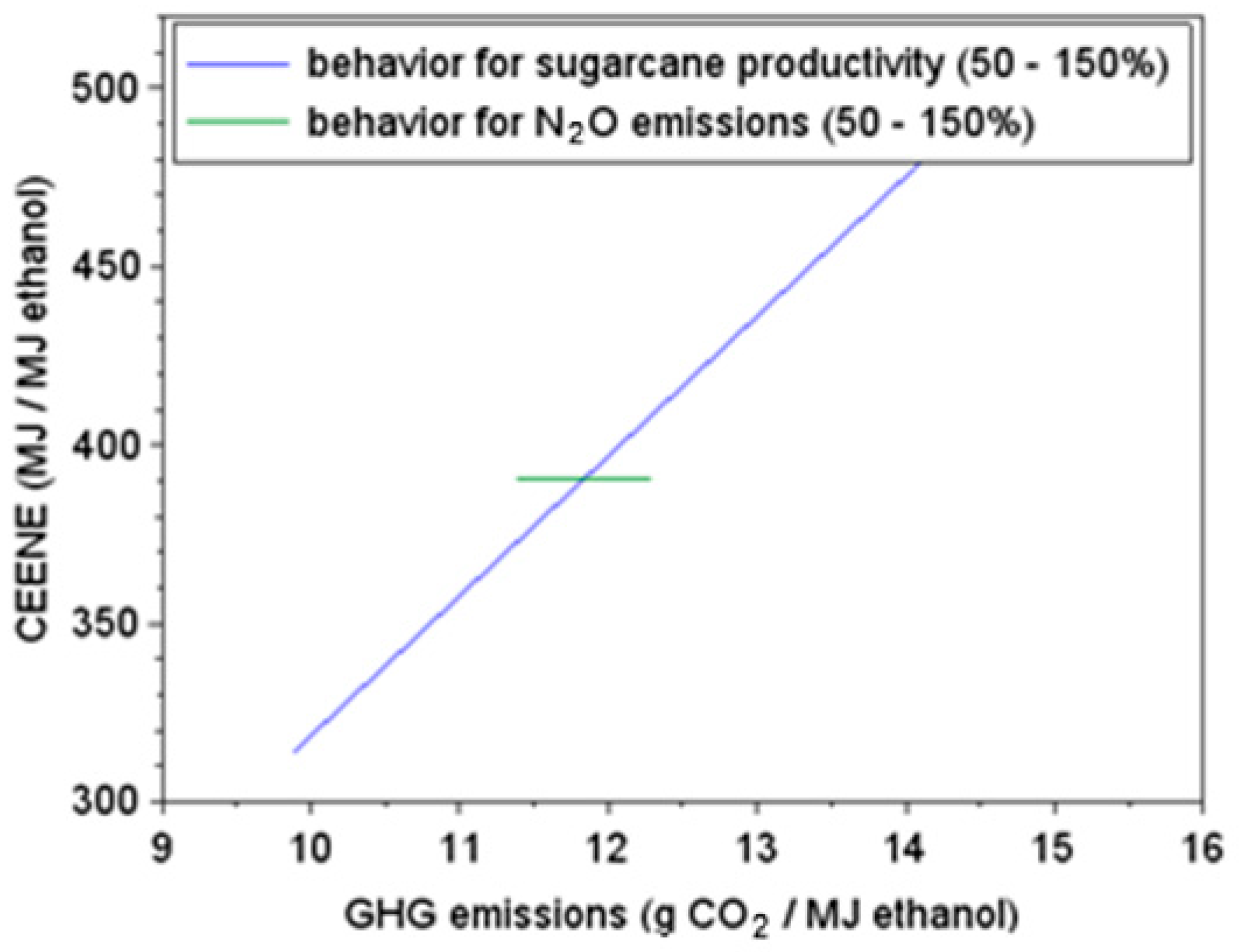
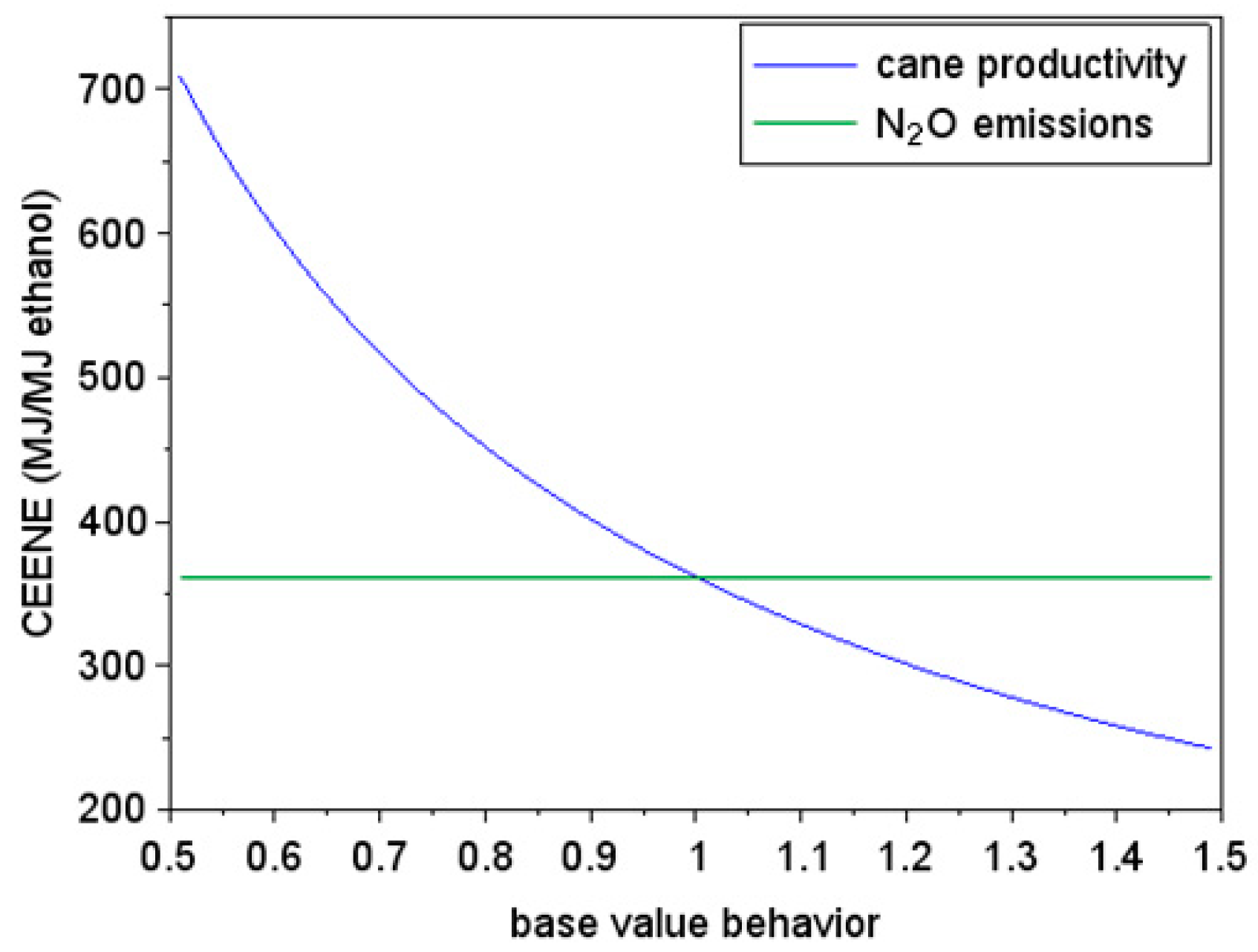
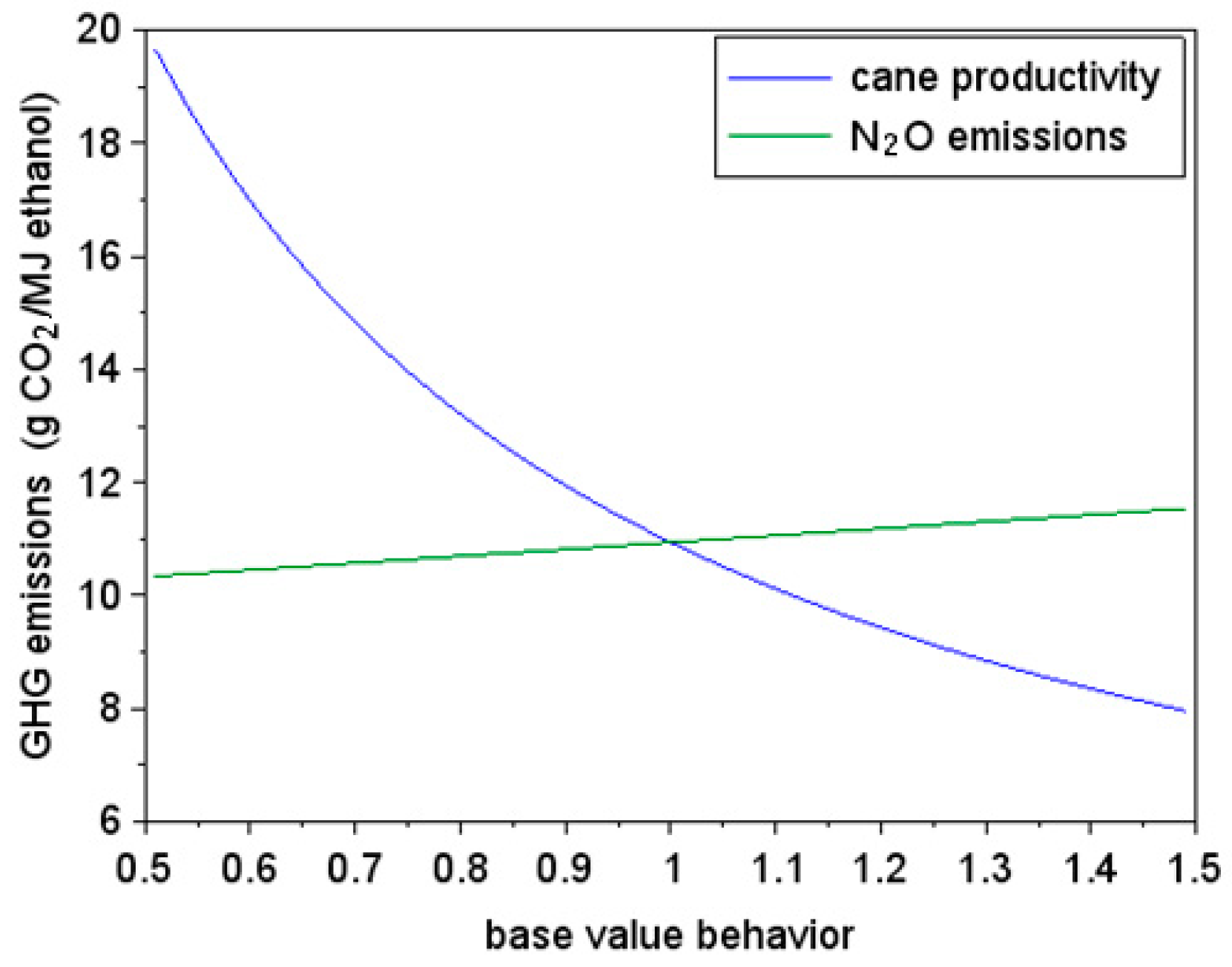
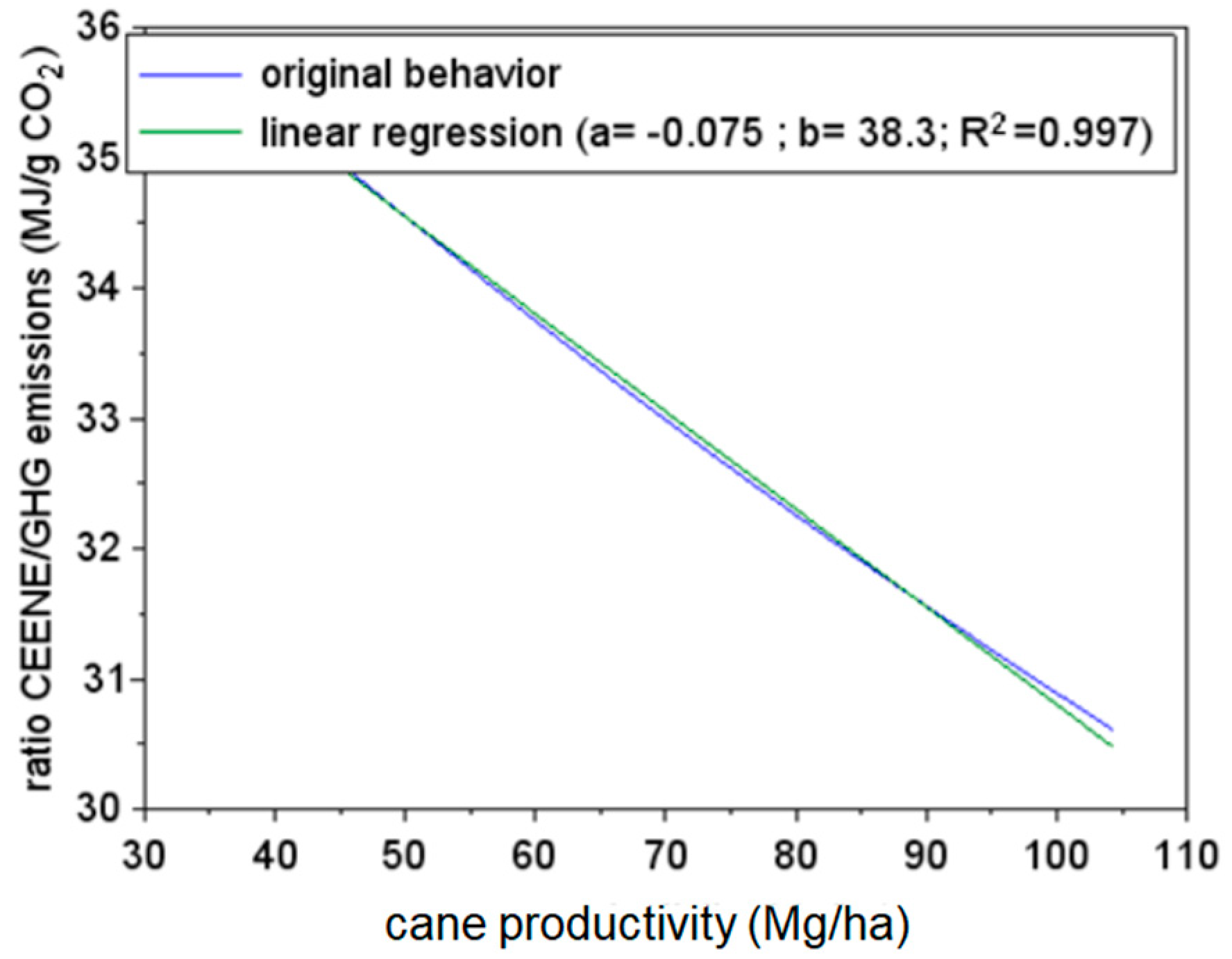
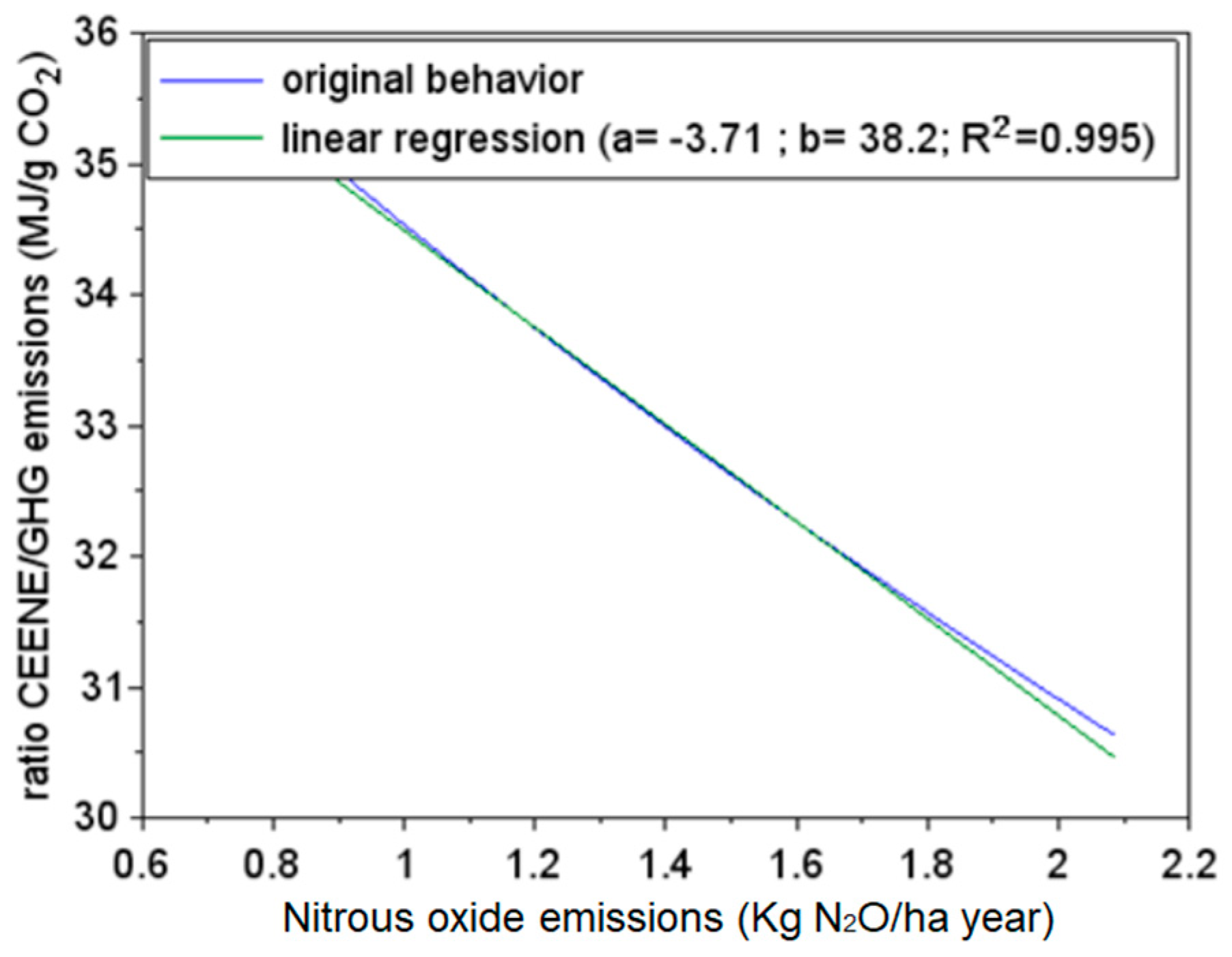
| Variable | Value | Unity | Description |
|---|---|---|---|
| Carb_ethanol | 0.4957 | dimensionless | Carbon in hydrated ethanol (calculated) |
| Rat_co2carb | 3.666 | dimensionless | Mass ratio CO2 mass carbon (calculated) |
| Ex_co2 | 0.45 | MJ/kg | Exergy of carbon dioxide [8] |
| Ex_h2so4 | 1.11 | MJ/kg | Exergy of sulfuric acid [8] |
| Ex_k2o5 | 4.40 | MJ/kg | Exergy of fertilizer K2O [8] |
| Ex_naoh | 0.18 | MJ/kg | Exergy of caustic soda [8] |
| Ex_nh3 | 19.9 | MJ/kg | Exergy of ammonia [8] |
| Ex_p2o5 | 2.91 | MJ/kg | Exergy of fertilizer P2O5 [8] |
| Ex_sdl | 0.08 | MJ/kg | Exergy of seedlings [8] |
| Ex_ww | 0.72 | MJ/kg | Exergy of whitewash [8] |
| App_k_ha | 100.0 | kg/ha | Annual average application rate of K2O [11] |
| App_ls | 0.65 | kg/SCT 1 | Annual rate of limestone application [11] |
| App_n_ha | 58.3 | kg/ha | Annual average application rate of fertilizer N [11] |
| App_p_ha | 36.7 | kg/ha | Annual average application rate of P2O5 [11] |
| En_h2so4 | 3.093 | MJ/SCT 1 | Energy for the production of H2SO4 [11] |
| En_herb | 11.24 | MJ/SCT 1 | Energy for the application of herbicides [11] |
| En_k2o | 6.69 | MJ/kg | Energy for the production of fertilizer K2O [11] |
| En_ls | 7.13 | MJ/SCT 1 | Energy for the application of limestone [11] |
| En_n | 61.45 | MJ/kg | Energy for the production of fertilizer N [11] |
| En_p | 9.61 | MJ/kg | Energy for the production of fertilizer P2O5 [11] |
| En_sdl | 5.88 | MJ/SCT 1 | Energy for the application of seedlings [11] |
| Rea_n_n | 0.01 | dimensionless | Reason N diminished N used in fertilization [11] |
| Bagasse_sct | 270.0 | kg/SCT 1 | Bagasse mass 50% wet [19] |
| Prod_cane | 70.0 | SCT/ha | Productivity of sugarcane [19] |
| Prod_ethanol | 88.0 | L/SCT 1 | Productivity of hydrated ethanol [19] |
| Diesel_dens | 0.85 | kg/L | Diesel density [20] |
| EF_diesel_kg | 3.7 | kg CO2-equivalent/kg Diesel | Diesel emission factor [20] |
| EF_fuel_mj | 0.07735 | kg CO2-equivalent/MJ | Emission factor of fuel oil [20] |
| Ethanol_dens | 0.79 | kg/L | Hydrated ethanol density [20] |
| Ex_diesel | 42.28 | MJ/kg | Exergy of diesel ≈ LHV [20] |
| Ex_dry_bagasse | 18.90 | MJ/kg | Dry bagasse exergy [21] |
| Ex_ wet_bagasse | 9.89 | MJ/kg | Exergy of bagasse that is 50% wet [22] |
| Ex_biochar | 16.00 | MJ/kg | Exergy of bagasse biochar [23] |
| Ex_cane | 5.76 | MJ/kg | Exergy of sugarcane [24] |
| Ex_ethanol | 27.64 | MJ/kg | Exergy of hydrated ethanol [24] |
| Ex_straw | 12.97 | MJ/kg | Exergy of straw that is 15% wet [25] |
| Diesel_ctr | 0.85 | kg/SCT 1 | Diesel consumed in cane transport [26] |
| Diesel_oah | 0.76 | kg/SCT 1 | Diesel consumed in agricultural operations and harvest [26] |
| Efic_KVA | 0.28 | dimensionless | Electricity generation thermal efficiency [26] |
| Port_straw | 0.5 | dimensionless | Portion of straw removed from the field for industry [26] |
| Straw_sct | 165.0 | kg/SCT 1 | Amount of straw mass that is 15% wet [26] |
| Pot_n2o | 265.0 | dimensionless | Potential greenhouse effect of nitrous oxide [27] |
| Sol_rad | 16.0 | MJm−2day−1 | Average annual solar radiation, SE, Brazil [27] |
| N° | Exergies | Emissions | Description |
|---|---|---|---|
| 1 | Ex1 | 1 | Sun |
| 2 | Ex2 | 2 | Captured CO2 sugarcane |
| 3 | Ex3 | 3 | Captured CO2 straw |
| 4 | Ex4 | 4 | Domestic energy consumption |
| 5 | Ex5 | 5 | Ethanol |
| 6 | Ex6 | 6 | Internal use of boiler bagasse |
| 7 | Ex7 | 7 | Extra use of boiler bagasse |
| 8 | Ex8 | 8 | Straw to boiler |
| 9 | Ex9 | 9 | Straw to soil |
| 10 | Ex10 | 10 | CO2 bagasse–straw from boiler |
| 11 | Ex11 | 11 | Electricity to electric grid |
| 12 | Ex12 | 12 | CO2 of fermentation |
| 13 | Ex13 | 13 | Agricultural operations and harvesting |
| 14 | Ex14 | 14 | Transportation of sugarcane |
| 15 | Ex15 | 15 | Fertilizer N |
| 16 | Ex16 | 16 | Fertilizer P2O5 |
| 17 | Ex17 | 17 | Fertilizer K2O |
| 18 | Ex18 | 18 | Limestone |
| 19 | Ex19 | 19 | Herbicides |
| 20 | Ex20 | 20 | Insecticides |
| 21 | Ex21 | 21 | Seedlings |
| 22 | Ex22 | 22 | Sulfuric acid |
| 23 | Ex23 | 23 | Caustic soda |
| 24 | Ex24 | 24 | Lubricants |
| 25 | Ex25 | 25 | Whitewash |
| 26 | Ex26 | 26 | Manufacture and maintenance of agricultural equipment |
| 27 | Ex27 | 27 | Manufacture and maintenance of buildings |
| 28 | Ex28 | 28 | Heavy industry equipment |
| 29 | Ex29 | 29 | Light industry equipment |
| 30 | Ex30 | 30 | Emissions of soil fertilizers (N2O) |
© 2019 by the authors. Licensee MDPI, Basel, Switzerland. This article is an open access article distributed under the terms and conditions of the Creative Commons Attribution (CC BY) license (http://creativecommons.org/licenses/by/4.0/).
Share and Cite
Araújo Júnior, J.; Caldeira-Pires, A.; Oliveira, S. Coupling Exergy with the Emission of Greenhouse Gases in Bioenergy: A Case Study Using Biochar. Energies 2019, 12, 1057. https://doi.org/10.3390/en12061057
Araújo Júnior J, Caldeira-Pires A, Oliveira S. Coupling Exergy with the Emission of Greenhouse Gases in Bioenergy: A Case Study Using Biochar. Energies. 2019; 12(6):1057. https://doi.org/10.3390/en12061057
Chicago/Turabian StyleAraújo Júnior, Jair, Armando Caldeira-Pires, and Sérgio Oliveira. 2019. "Coupling Exergy with the Emission of Greenhouse Gases in Bioenergy: A Case Study Using Biochar" Energies 12, no. 6: 1057. https://doi.org/10.3390/en12061057
APA StyleAraújo Júnior, J., Caldeira-Pires, A., & Oliveira, S. (2019). Coupling Exergy with the Emission of Greenhouse Gases in Bioenergy: A Case Study Using Biochar. Energies, 12(6), 1057. https://doi.org/10.3390/en12061057





